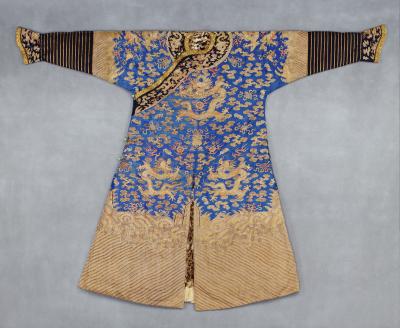
Manchu Man's Semiformal Court Robe
Artist not known, China
Mid-1800s, Qing dynasty
H: 58 in, W: 78 in
Denver Art Museum, Neusteter Textile Collection: Gift of Caroline Bancroft, 1942.1
Photograph © Denver Art Museum 2011. All Rights Reserved.
Exquisitely woven dragon robes are the best-known garments from the lengthy Qing (CHING) dynasty (1644–1911). They were handmade in factories following design specifications established by the Office of the Imperial Household. Some weaving was done in the Forbidden City in Beijing (home of the emperor and the highest-ranking officials), but the majority was carried out at factories in the cities of Suzhou, Hangzhou, and Nanjing.
Government officials and members of the imperial court were entitled to wear dragon robes. Designs and colors were regulated by rank; for example, only the emperor, the heir apparent, empress, and empress dowager could wear yellow robes. Only the imperial family and high-ranking princes were allowed to wear robes with nine dragons (see the "Details" section to locate the dragons on this robe). Likewise, only the upper echelons were allowed to wear dragons with five claws; the lower orders wore four-clawed dragons. However, by the end of the 1800s, these conventions were often ignored.
This robe is completely lined with leopard fur - an unusually luxurious and expensive choice. Most winter robes were padded with cotton or silk wadding.
Imperial rules dictated what a dragon robe could look like. Some of the symbols on the robe signaled what rank the wearer held. Other symbols were designed to bring good fortune to the wearer.
Dragons were believed to bring rain. Since China was mostly an agricultural economy, rain was incredibly important. Dragons were thus symbols of fertility and masculine vitality. The dragon also represented the emperor and, therefore, China. A dragon was believed to appear in the sky at the birth of the emperor.
The decorations on the dragon robe depict the universe: the sky, mountains, and the sea. The neckhole represents the “Sky Door” or gate of heaven. Wearing the dragon robe made the symbolism complete.The neckhole separates the material world of the coat from the spiritual world, embodied by the wearer’s head.
Nine five-clawed golden dragons with flaming pearls appear on this festive dress. Among the clouds surrounding the dragons are symbols related to Buddhism.
Details

The Ninth Dragon
This robe has nine dragons: one center front, one center back, two bottom front, two bottom back, and two on the shoulders. The ninth dragon is on the inner flap and can only be seen when the robe is opened as in this detail. The number “nine” represents eternity.
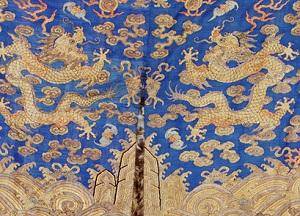
The Sky
The sky or heavens section of this dragon robe is filled with dragons chasing flaming pearls, bats (a sign of good fortune), and many clouds (symbols of heaven, fertility, and long life).
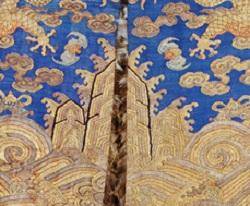
The Mountains
The four mountains represent the four outermost peaks of a great central mountain, which was believed to form the earth’s axis. The mountains symbolized longevity, the earth, and resoluteness. This detail of a mountain peak is located at the center front of the robe. The other three peaks appear at the center back and at the left and right side of the bottom of the robe.

Five Claws
Even the small dragons on the sleeve cuffs have five claws. Traditionally, dragons with five claws were permitted on the garments of only the highest-ranking officials.
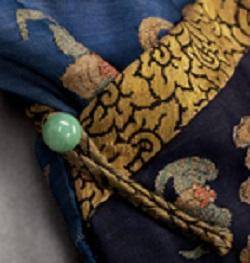
Glass Buttons
Another sign of the high quality of this robe is that the buttons are made of colored glass in imitation of jade.

Buddhist Symbol: Conch Shell
Conch shells could be blown like a horn to call people to worship. The conch shell stands for the far-reaching nature of Buddhist teaching.
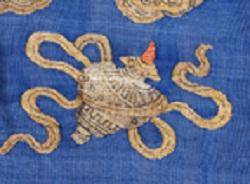
Buddhist Symbol: Vase
The vase holds the elixir of life and stands for the fulfillment of all wishes.
More Resources
Making Silk
Learn about the tradition of silk making and how it is done today. This video from the American Museum of Natural History is illustrated with old images of how silk making was done in the past, and has an interview with an expert. About 3 minutes.
Silkworm Care, Part 1
Silkworm Care, Part 2
This two part (each part is about 6 minutes) video features a young boy telling, in detail, how he cares for his silkworms. Great information that might be interesting for students to watch.
Websites
Rank and Style: Power Dressing in Imperial China
Includes PDF to print, details on symbols, excellent overview.
Chinese Dress in the Qing Dynasty
Good overview that includes suggested activities for students.
Chinese Dragon Robe
A museum staffer from the Oklahoma History Center tells the story of a dragon robe and what is personally appealing about it.
Traditions: Clothing and Ornaments
This website has pictures and descriptions of hats, coats, dragon robes and other clothing worn by high ranking people in Qing Dynasty China.
Imperial Chinese Dress and the Eastern Dragon
This is an instructional unit for secondary school students, from the National Consortium of Teaching About Asia. The author says: “My primary goal was to teach children to understand and employ techniques and information from the field of art as they explore the world through broad and rich learning experiences.”
Power|Play: China's Empress Dowager
Learn about a recent exhibition at Smithsonian's Sackler Museum of Asian Art about the Empress Dowager Cixi (1835–1908) , who was the dominant political figure of China's Qing dynasty.
Chinese Environment
Students can learn about the wide variety of natural environments that exist in mainland China which includes deserts and forests.
Chinese Embroidery
This website produced by ChinaCulture.org includes very detailed information about silk embroidery, which is practiced nearly all over China. In particular, this website focuses on "The Four Famous Embroideries of China."
Costume in the Qing Dynasty
Discover the complex and fascinating history of clothing during the Qing Dynasty in China. This was a period of many shifts and innovations in the traditional dress codes.
Books
Dickenson, Gary, and Linda Wrigglesworth. Imperial Wardrobe. Berkley, CA: Ten Speed Press, 2000.
Well illustrated book about the clothing that imperial authorities dictated must be worn for various ceremonial events in China’s last imperial dynasty.
Garrett, Valery. Chinese Dress: From the Qing Dynasty to the Present. North Clarendon, VT: Tuttle Publishing, 2007.
A comprehensive look at the wide range of dress from the Qing dynasty in China up to the present day. Shows clothing worn not only the wealthy but by the merchants and women as well.
Garrett, Valery. Chinese Dragon Robes. Hong Kong: Oxford University Press, 1998.
An in-depth look at the symbolism and customs surrounds the dragon robes of the Chinese Qing dynasty.
Garrett, Valery. Chinese Clothing: An Illustrated Guide. New York: Oxford University Press, 1994.
This valuable comprehensive reference covers the whole range of Chinese clothing including court dress, textiles, accessories, children's wear, rural clothing, and wedding and funeral attire.
Coleman, Teresa. Dragons and Silk from the Forbidden City. Odyssey Publications, Ltd., 1999.
A concise introduction to a complex topic. Good for teachers and secondary students, this book is short and well illustrated.
Children’s Books
Friedman, Mel. Ancient China. New York: Children’s Press, 2010.
Fun facts about China and its culture including inventions, military history, traditions and dress. Best for grades 2-6.
Crane, Carol. D is for Dragon: A China Alphabet. Chelsea, MI: Sleeping Bear Press, 2006.
An alphabet book for the culture of China. Each letter gives a fun, simple rhyme and then has a few paragraphs giving more in-depth explanations on the topic. Good for grades K-4.
Yen Mah, Adeline. China: Land of Dragons and Emperors. New York: Delacorte Press, 2008.
A general history of China from 259 BCE to the present, focusing on the role of the dragon and the emperor. A chapter book with lots of maps and pictures, this book is best for grades 5-8.
Smith, Jeremy, and Jackie Gaff. The Last Emperor. Ohio: Brighter Child, 2002.
Recommended for grades 4-8. A great way to see history through the eyes of a child, Puyi, who became emperor at age 3, but then lived through a revolution in China that destroyed imperial rule. Well illustrated.
Cotter, Charis. Kids Who Rule: The Remarkable Lives of Five Child Monarchs. Buffalo, NY: Annick Press, 2007.
For ages 9-12, this book covers the lives of five child monarchs, including Puyi, the last emperor of China.
Funding for object education resources provided by a grant from the Morgridge Family Foundation. Additional funding provided by the William Randolph Hearst Endowment for Education Programs, and Xcel Energy Foundation. We thank our colleagues at the University of Denver Morgridge College of Education.
The images on this page are intended for classroom use only and may not be reproduced for other reasons without the permission of the Denver Art Museum. This object may not currently be on display at the museum.
